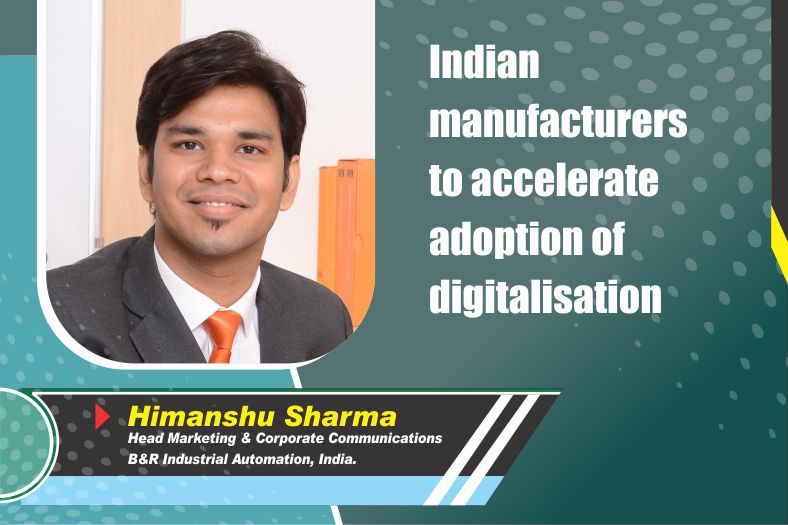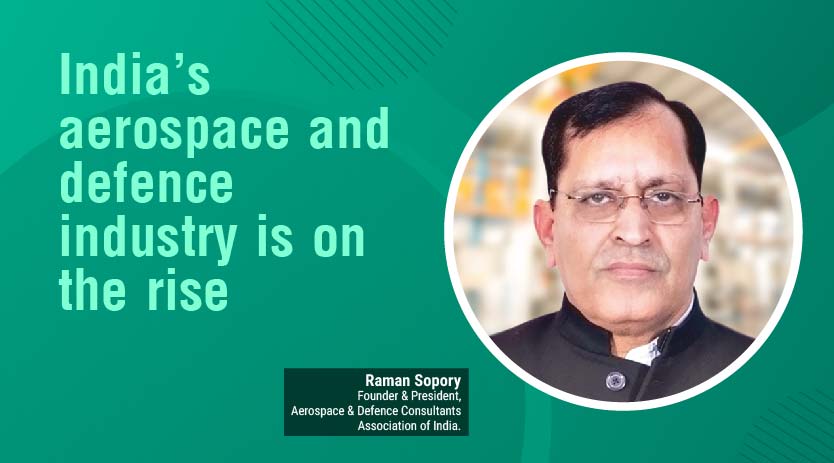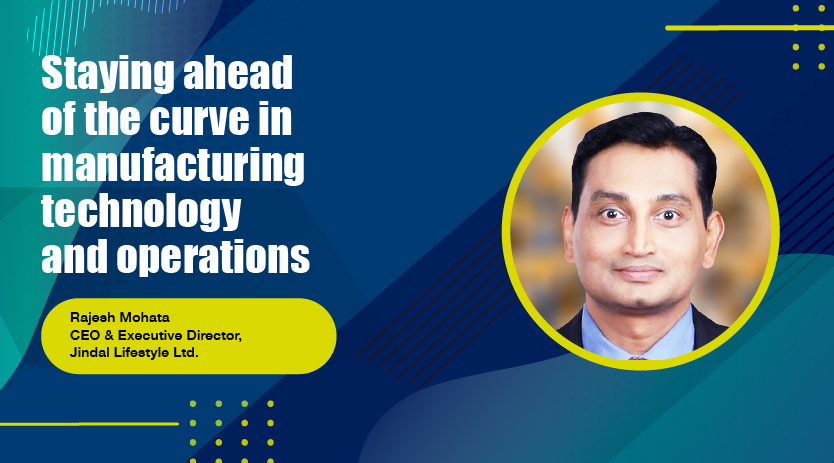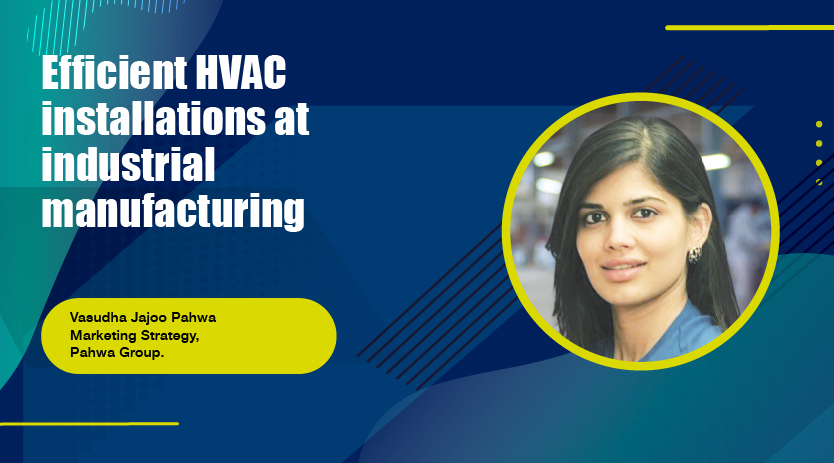Indian manufacturers to accelerate adoption of digitalisation
March 1, 2022 7:33 pm
To be globally competent, Indian industries must compete on seamless quality, cost-effective solutions, higher efficiency with maximum return.
With the increasing penetration of digitalisation, the deployment of automation in the manufacturing industries, including the health industry, automotive, oil and gas,infrastructure, retail, and other industries such as logistics, is growing exponentially says, Himanshu Sharma, Head Marketing & Communication, B&R Automation, India while sharing his views with OEM Update.
Extending further he says, automation in manufacturing refers to the use of connected and smart machines and shop floors to automate industrial processes. Indian manufacturing industries are refining their automation competencies to meet the global competition. This is further supplemented by the increased awareness about digitalisation and focused government initiatives, which are expected to impact the automation market’s growth in India positively.
Evaluating demand for automation, AI and robotics in bridging the technological gap in Indian industries
Indian industries are adopting more advanced technologies like automation, AI, and robotics than ever before. For many industries, it’s no longer a question of whether to automate, only when and to what extent. In all its forms, advanced technology is drastically changing the face of the Indian manufacturing industry. Due to increasing market competitiveness and continuous product innovation, new skills are required in many areas.To be globally competent, Indian industries must compete on seamless quality, cost-effective solutions, higher efficiency with maximum return on investment (ROI), and minimum time to market (TTM). Advanced technologies are vital to achieve this.
Measures to ensure safety and security in managing automated industries in manufacturing?
Advanced automation technologies demand flexible, modular production lines. Global trends like Industrial IoT, advanced automation, robotics, and digitalisation are helping Indian manufacturing industries to build highly efficient machines and lines. In India, machine builders evaluate technologies and solutions and map their paths to implementation, for which B&R India is highly appreciated and preferred. We have solutions for future needs resulting in a significant competitive edge in smart manufacturing and production effectiveness. There is an increasing demand for reduced downtime, energy consumption, and higher throughput and product quality. On the shopfloor, advanced automation and robots are helping industry to eliminate human error, remove the potential for human contamination, increase accuracy and reproducibility. In the pharmaceutical plant, to develop and test new drugs, advanced automation technology and robots are being used to perform repetitive tasks like stirring, blending, and titration, allowing scientists to make better use of their education and know-how. Our OpenROBOTICS seamlessly integrates robots into the machine control system. New available software features make it easier than ever for industries to synchronise robots with B&R’s track-based transport systems and other dynamic machine components. It has completely uniform programming for every component on the production line and has benefits from development and operation to diagnostics and maintenance. Together with B&R’s SafeROBOTICS software package, human operators can work safely shoulder-to-shoulder with robots without the restrictions of safety cages.
Innovative practices being adopted specific to pharma manufacturing in view of safety protocols
In India, we have recently launched PharmaEdge, an integrated, out-of-the-box, optimised offering for the pharmaceutical manufacturing industry to comply with applicable regulatory requirements. Our PharmaEdge solution helps achieve cyber-security and advanced detailed analytics, reporting, and business intelligence. It offers all benefits of SCADA and a robust control system in one device. With possibilities to add energy monitoring, condition-based predictive maintenance, and MES / ERP connectivity, PharmaEdge enables the implementation of connected and smart machines and lines.Quality, safety, compliances to various standards and norms, availability of data, ease of track and trace, and innovative emanufacturing are the trademarks of a world-class pharmaceutical facility. Many pharma companies look at the age-old SCADA solution to fulfil these requirements. However, with the demands of a futuristic facility on the rise, only data acquisition does not suffice, and factories demand faster & accurate systems with possibilities of energy monitoring, condition-based maintenance, predictive maintenance, MES / ERP connectivity, reporting, and advanced analytics. Today, it is the need of the hour for companies to have a one-stop solution and an integrated approach to the existing possibilities and become ready for the future.
Challenges and opportunities prevail adopting factory automation and robotic automation processes
Its goal is to change conventional industrial production plants into smart factories by integrating diverse technologies like automation and robotics. However, most efficiently adapting these concepts into the factory remains a significant challenge. There is no clear understanding of the cost of integration, lack of standards, inflexibility, better balance of speed and safety, data protocols, and improvements to enabling technologies. These are some of the challenges holding back the adoption of factory automation and robotic automation processes. The good news is that there are more opportunities to boost industries to implement factory automation and robotic automation processes irrespective of the challenges. We should not neglect the challenges and not see them as barriers. The opportunities are far more beneficial. Higher competence & productivity, sustainability, increased overview of the maintenance plan, forecasting line production efficiency that allows customers to support higher RoI and lower TTM are strong enough reasons to take the next step.
Technology and digitalisation are key factors in driving the sector’s growth
Creating a digital space and boosting technology and digitalisation can yield substantial economic and social benefits to communities. Technology advancements and digitalisation are the keys to modernisation. That’s why more and more manufacturers are accelerating their digital transformation programs every year. When the world was faced with the pandemic’s disruption, Indian manufacturers, big players, SMEs and MSMEs realised their existing systems required flexibility, speed, and transparency to adapt. In that light, it’s no surprise that manufacturers stepped on the gas last year, speeding up their digital transformation by months and years. Like so many other breakthrough technologies, digitalisation makes it possible to do things in entirely new and beneficial ways. While establishing a new factory set up, even before breaking ground, the most advanced manufacturers use a “digital twin” to configure the plant model virtually. They can see how workforces will work and interact with machines. The manufacturers use the same digital model in a virtual setting to be fully expertand efficient from day one. With the help of technology and digitalisation, an entire factory can be commissioned virtually, saving time and money.
Concluding his remarks, Himanshu expressed that Indian manufacturers need to accelerate the adoption of digitalisation. Over the last two years, mainly the Indian pharmaceutical industry has seen first hand the power of digitalisation. B&R digitalisation technologies have helped the pharma industry accelerate production and efficiency.
Cookie Consent
We use cookies to personalize your experience. By continuing to visit this website you agree to our Terms & Conditions, Privacy Policy and Cookie Policy.


















